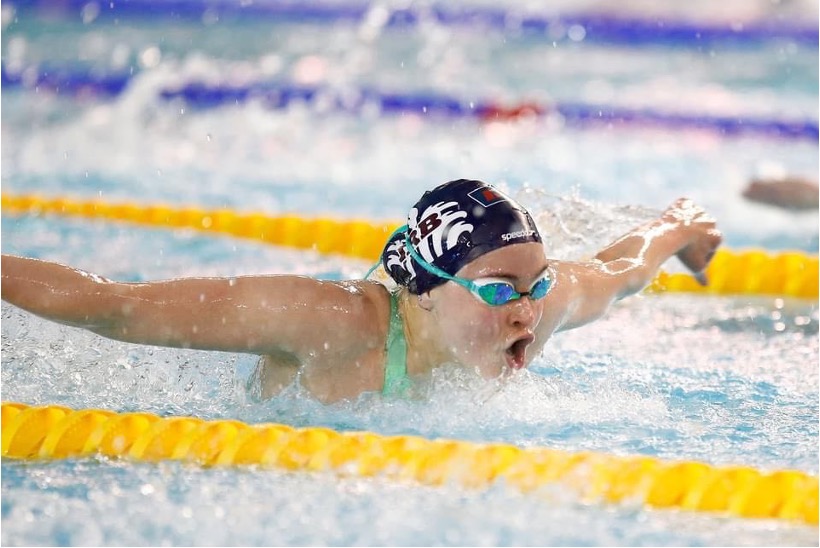By Gunnhildur Baldursdottir
We often think, “This would never happen to me or someone that I love” until it does, and your world is suddenly upside-down. That’s how it was in our family when my 17-year-old sister, Solveig, dealt with an eating disorder.
We have always been close since day one. In 2018, she started slowly fading away from me until it felt like I’d lost her.
How it happened
It all started in 2017 when she began feeling pain in her elbow. After a visit to the doctor, it was clear she had Panner’s disease. It occurs in teenagers, but the disease is temporary and takes 2-6 years to heal. When not enough blood can access the tissues in the bone, the tissue dies and a hole starts to form.
Because she was no longer able to train for swimming, she wanted to do better in other areas of her life to stay in shape. Solveig’s mental state could be described as a “control freak.” Panner’s disease was something she couldn’t control, but she found something she could control, and she went all in.
Reflecting on the situation, Solveig said, “I was shocked that I had to almost quit swimming, but I did some kicking. With time, I got depressed because my self-image was all built on my sport. I thought it was easier to hate my body more by eating less to punish myself. I downloaded the MyFitnessPal app because it helped me to count all my calories. Very soon I knew the calories for every single food by memory.”
Rock bottom
Two years after the diagnosis, Solveig hit rock bottom. The hole in her elbow was almost healed, but being back in training while being so skinny didn’t help her swimming at all.
“I had mastered the skill of lying, so the [eating disorder] had been going on for a lot longer,” she said.
She had lost control. This was evident when her friend told her to delete the MyFitnessPal app.
“Before I knew [it], I was screaming my lungs out like Gollum protecting his precious ring — that was my disease talking. This is the worst part about the disease: how much the personality changes. I didn’t have any opinion or any emotion anymore except anger. Thinking about food took all my energy, so there was nothing else left,” Solveig said.
Our parents, Harpa and Baldur, were getting seriously worried — her plan of staying in shape had turned into a nightmare.
“No matter how many times I took her to the doctor, no one seemed to understand the seriousness of the disease,” my father said.
In my mother’s words, “The best offer the health care in Iceland could give us was a six-month long waitlist for mental help.” Harpa and Baldur were not giving up, and they found a private counselor. After seeing her counselor for a while, Solveig said “It turned out that we never really connected. The counselor just kept saying that things take time, and it will get better, but I was only getting worse.”
When the ban on gatherings hit Iceland in March 2020, everything collapsed. Solveig had become even more sick. An eating disorder is life-threatening both mentally and physically. It can destroy your body. People can lose their will to live. For example, Solveig was not getting her period — among other organic errors.
“Her appetite regulation was destroyed; she had no idea when, how much or what to eat anymore. Her brain had also shut down to complete survival mode. She was already reaching the point where she couldn’t study, talk to friends. Her brain was starving,” Harpa said.
Harpa, Baldur and Solveig decided it was best for her to stop seeing the counselor.
Solveig met with a strong team of counselors, doctors and nutritionists in Iceland, all specialized in treating adolescents with eating disorders.
How swimming helped
By the end of 2020, Solveig was eating again without feeling terrible, but all of this effort would have been useless if she didn’t have the strong will to get better. Swimming was the key for Solveig’s recovery. She realized if she would not eat, she would never become a better swimmer.
Solveig is still under supervision, but it is priceless to see her dancing with herself and smiling again.
“It helped me a lot to see what my body could do for me, like wow, my muscles help me move fast in the water! It is just such a relief. Who thinks, anyway, when they are 90 [years old] about their size when they were younger? In the end, you only think about the people you met and the memories you had from your eventful life,” Solveig said.
What to do if you are someone in this situation
Solveig talked about more things that can help others in the same situation.
“First of all, get help sooner than later! Yes, it is hard, but think of it as a period that will help you through the rest of your life. Just remember that it will get better. Anyone can go through this if intervened in time, and they want it bad enough.”
